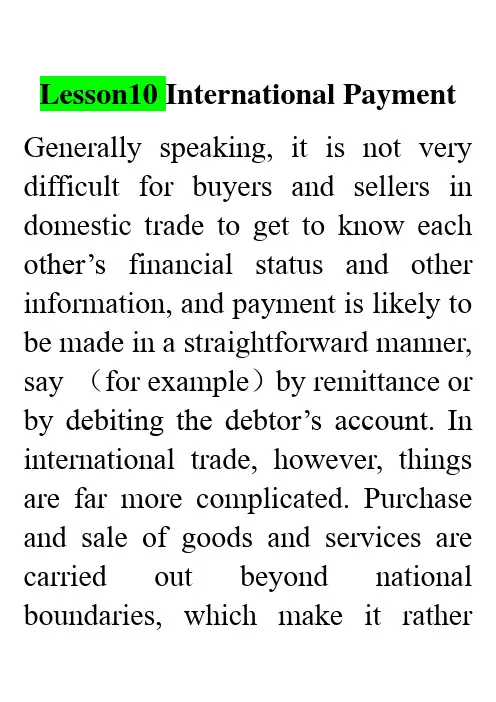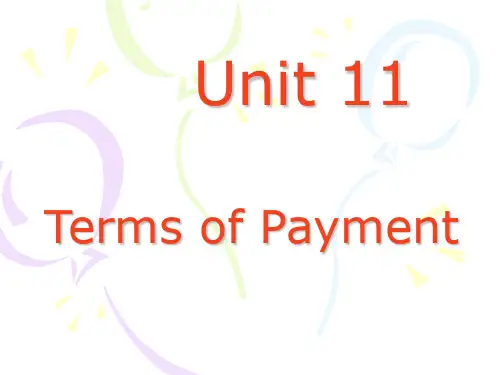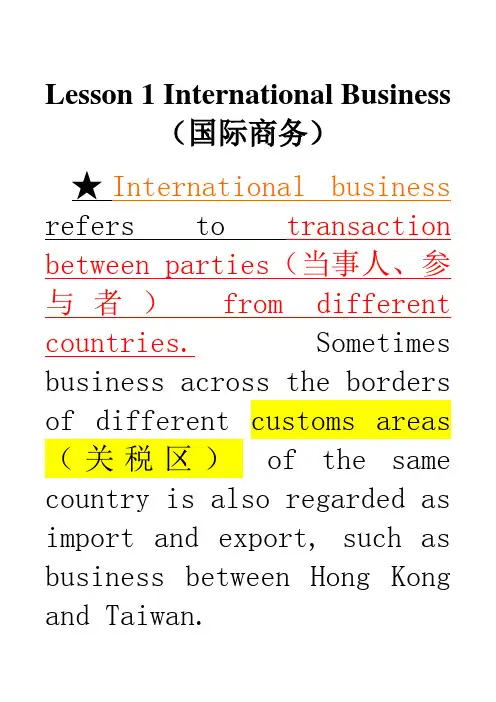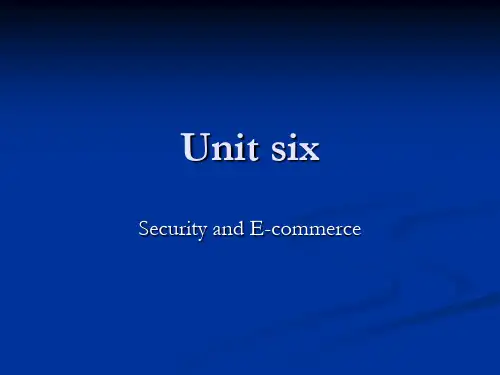国际商务英语课文电子版lesson (11)
- 格式:doc
- 大小:40.00 KB
- 文档页数:11



Lesson10 International Payment Generally speaking, it is not very difficult for buyers and sellers in domestic trade to get to know each other’s financial status and other information, and payment is likely to be made in a straightforward manner, say (for example)by remittance or by debiting the debtor’s account. In international trade, however, things are far more complicated. Purchase and sale of goods and services are carried out beyond national boundaries, which make it ratherdifficult for the parties concerned in the transaction to get adequate information about each other’s financial standing and creditworthiness (资信;信誉). Therefore, mutual trust is hard to build. Both the exporter and importer face risks as there is always the possibility that the other party may not fulfill the contract.For the exporter there is the risk of buyer default(不按期付款). The importer might fail to pay in full for the goods. He might go bankrupt.His government might, for various reasons, ban(禁止)trade with the exporting country or ban imports of certain commodities. The buyer might run into difficulties getting the foreign exchange to pay for the goods. It is even possible that the buyer is not reliable and simply refuses to pay the agreed amount on various excuses.On the part of the importer, there is the risk that the shipment will be delayed, and he might only receive them long after payment.The delay may be caused by problems in production or transportation, and such delays may lead to loss of business. There is also a risk that wrong goods might be sent as a result of negligence(疏忽大意)of the exporter or simply because of his lack of integrity (honesty).Political risks such as war, quotas, foreign exchange control; commercial risks like market change and exchange rate fluctuations(波动); and even language barriers all add upto (increase)the problems in international trade. Because of these problems and risks, exporters are hesitant to release their goods before receiving payment, while importers prefer to have control over the goods before parting with their money.Various methods of payment have been developed to cope with different situations in international trade. When the political and economic situation in the importing country makes payment uncertain or when the buyer’s credit standing isdubious (doubtful), the exporter may prefer cash in advance or partial cash in advance. In this case, the importer has no guarantee that the exporter will fulfill his obligations once he has made payment by cash. If the buyer and the seller know each other well, they may decide to trade on open account. This means that no documents are involved and that legally (in terms of law) the buyer can pay anytime. The seller loses all control over the goods once they have been shipped. Sales on thisbasis are usually paid for by periodic payment, and obviously the exporter must have sufficient financial strength经济实力to carry the cost of the goods until receiving payment. If the exporter wishes to retain(保留)title or ownership(所有权)to the goods, he can enter into consignment transactions. This means the exporter has to send his goods abroad and will not get payment until the goods are sold. If not sold, the goods can be shipped back. Therefore, this arrangementshould only be made with full understanding of the risks involved and is preferably to be limited to stable countries where the exporter has a trusted agent to look after his interest.A lot of international transactions are paid for by means of the draft(汇票), which, also referred to as the bill of exchange, is an unconditional(无条件的)order to a bank or a customer to pay a sum of money to someone on demand(立即)or at a fixed time in the future.The person who draws(开立)the draft, usually the exporter, is called the drawer(出票人), and the person to whom the draft is drawn is called the drawee(受票人). There is yet another party payee(收款人), i.e. the person receiving the payment, who and the drawer are generally but not necessarily the same person, as the drawer can instruct the drawee either to pay “to the order of ourselves” or to the order of someone else, for instance, the bank.A draft is either a sight draft ora usance draft (also called tenor draft or term draft). The former calls for (needs)immediate payment on presentation (提示) to the drawee while the latter is payable at a later date, e.g. 30, 45, 60, or 90 days after sight or date. A draft is either clean (clean draft 光票) (without documents) or documentary (documentary draft跟单汇票). In the latter case, the draft is accompanied (attached)by the relevant documents such as the bill of lading, the invoice, the insurance policy etc.In documentary collection ( 跟单托收), the exporter sends the draft and the shipping documents运输单据representing title to the goods to his bank, which forwards (sends) them to anot her bank in the importer’s country, which in turn contacts the customer (importer). In the case of documents against payment (D/P)付款交单, documents will not be released to the importer until payment is effected执行. There are D/P at sight and D/P after sight. The former requires immediate paymentby the importer to get hold of the documents. The latter gives the importer a certain period after presentation of the documents, but documents are not released to him until he actually pays for the merchandise货物. In the case of documents against acceptance (D/A)承兑交单, documents are handed over to the importer upon his acceptance(承兑)of the bill of exchange drawn by the exporter. Payment will not be made until a later date. D/A is always after sight.So far as the exporte r’s interest is concerned, D/P at sight is more favorable than D/P after sight, and D/P is more favorable than D/A. In actual trade, payment by collection should be accepted with discretion (小心). It is usually used when the financial standing of the importer is sound(良好的), or when the exporter wishes to push the sale of his goods, or when the transaction involves only a small quantity. Otherwise, the letter of credit is generally preferred.Lesson 11In international trade it is almost impossible to mach payment with physical delivery (实际交货) of the goods, which constitutes conflicting problems for trade, since the exporter prefers to get paid before releasing the goods and the importer prefers to gain control over the goods before paying the money. The letter of credit is an effective means to solve these problems. Its objectiveis to facilitate international payment by means of the credit-worthiness of the bank. This method of payment offers security to both the seller and the buyer. The former has the security to get paid provided (假如) he presents impeccable(没有缺陷的)documents while the latter has the security to get the goods required through the documents he stipulates in the credit. This bilateral security is the unique and characteristic feature of the letter of credit.“Letter of credit” is often shortenedas L/C or L.C. and is sometimes referred to as “banker’s commercial letter of credit”, “banker’s credit”, “commercial credit” or simply “credit”. Modern credits were introduced 开始采用in the second half of the 19th century and had substantial development after the First World War. The credit is a letter issued by a bank at the request of the importer in which the bank promises to pay upon presentation of the relevant documents. It is actually a conditional bank undertaking(承诺)of payment.The operation of the letter of credit starts with the importer. He instructs his bank to issue an L/C in favor of the seller (以…为收益人)for the amount of the purchase. Here the importer is called the applicant (开证申请人), or opener, principal etc., the bank that issues the credit is called the opening bank, the issuing bank or the establishing bank, (开证行) and the exporter in whose favor the credit is opened is called the beneficiary(受益人). The openingbank sends the credit to its correspondent bank(往来行)in the exporter’s country, who will, after examining(检查)the credit, advise (通知)the exporter of its receipt. Here the correspondent bank is called the advising bank(通知行). The exporter or beneficiary will make a careful examination(仔细检查)of all the contents of the credit and will request the opener to make amendments修改to any discrepancies (不一致)in the credit so as to ensure safe and timelypayment. Sometimes the exporter may require a confirmed letter of credit (保兑信用证) either because the credit amount is too large, or because he does not fully trust the opening bank. The bank that adds its confirmation(保兑)to the credit is called the confirming bank which is undertaken(承担)either by the advising bank or another prime (big)bank. When everything with the credit is in order, the exporter will prepare the relevant documents based on the credit and dispatch thegoods to the importer. Then he will present the draft and the accompanying documents to the advising bank that pays or accepts (承兑) or negotiates(议付)the bill of exchange. The advising bank then also becomes the paying bank which acts as the agent of the opening bank and gets reimbursed(pay back)by the opening bank after paying the beneficiary. If a bank, either nominated (指定)by the opening bank or at its own choice, buys the exporter’s draft submitted to it undera credit, it is called a negotiating bank (议付行). The draft and the documents will then be sent to the opening bank for reimbursement(偿付).Letters of credit are varied in form, length, language, and stipulations. Generally speaking, however, they include the following contents:1. The number of the credit and the place and time of its establishment.2. The type of the credit.3. The contract on which it is based.4. The major parties relevant to thecredit, such as the applicant, opening bank, beneficiary, advising bank. etc.5. The amount or value of the credit.6. The place and date on which the credit expires(失效).7. The description of the goods including name of commodity, quantity, specifications, packing, unit price, price terms, etc.8. Transportation clause(条款)including the port of shipment, the port of destination, the time of shipment, whether allowing partial shipments or transshipment(转船).9. Stipulations relating to the draft.10. Stipulations concerning the shipping documents required.11. Certain special clauses if any.e.g. restrictions on the carrying vessel(承运船只)and the route.12. Instructions to the negotiating bank.13. The seal or signature of the opening bank.14. Whether the credit follows “the uniform customs and practice for documentary credits”.The letter of credit providessecurity to both the exporter and the importer. However, it only assures payment to the beneficiary provided the terms and conditions of the credit are fulfilled. It does not guarantee that the goods purchased will be those invoiced or shipped. It is stipulated in Article 4 of the uniform customs and practice for documentary credit that “in credit operations all parties concerned deal in documents, and not in goods, services and/or other performance to which the documents may relate”.That is to say the banks are only concerned with the documents representing the goods instead of the underlying contracts. They have no legal obligation whether the goods comply with the contract. They will be considered as having fulfilled their responsibility so long as all the documents comply with the stipulations of the credit. The quality and quantity of merchandise shipped, although specified in the documents, ultimately depend on the seller who has manufactured, packaged, andarranged shipment for the goods.If the importer finds any problems with the goods, e.g. inferior quality or insufficient quantity, he has to contact or even take legal action against the exporter instead of the bank so long as the documents are “proper” on their face.Lesson 12Letters of credit fall under several categories depending on their function, form and mechanism. Here are the major types of credit:1. Clean credit and documentary credit: Credits that only require clean draft, i.e. draft not accompanied with shipping documents, for payment are clean credit. They are generally used in non-trade settlement(非贸易结算)or in payment in advance by means of the L/C. Most of the credits used in international trade are documentary credits, i.e. credits that require shipping documents to be presented together with the draft.2.Revocable credit andirrevocable credit: This classification is based on the certainty确信of the commitment 承诺to pay on the part of the applicant and the issuing bank. The credit is a revocable one if such commitments can be altered (改变)or even canceled(取消)without consulting with the beneficiary. It is quite obvious that the exporter has little assurance 保证to get payment, and therefore this type of credits are rarely used. Irrevocable credits are those that cannot be amended (revised修改)or revoked(取消)without the consent(同意)of all the parties concerned. Safe and reliable, this type is extensively(widely)used in world trade. It must be noted that if there is no specific indication whether a credit is revocable or irrevocable, it should be regarded as irrevocable.3. Confirmed credit and unconfirmed credit: If a credit is confirmed by a bank other than (除…之外)the issuing bank, it becomes a confirmed credit. The confirmation is undertaken 承担either by theadvising bank or by another leading bank. Under a confirmed credit, the beneficiary is given double assurance of payment 双重付款担保since the confirming bank has added its own undertaking 承诺to that 承担of the opening bank. If the credit is not confirmed by another bank, it is an unconfirmed letter of credit. Though a confirmed credit is considered to be able to provide the greatest degree of security to the beneficiary, it involves additional cost as a result of the confirmation.Therefore if the establishing bank is a reliable prime bank, confirmation may not be necessary.4. Sight credit and usance credit: A sight credit is one by which payment can be made upon presentation of the draft and impeccable documents by the beneficiary to the bank. It gives the beneficiary better security and helps him speed up his capital turnover. 资金周转Most of China’s export contracts stipulate for sight credit in payment terms. Obviously, a sight credit calls for a sight draft.It is also clear that this type of credit requires a usance draft. If the beneficiary wishes to get payment before the maturity到期of the draft, he can ask the bank to discount贴现the acceptance, and immediately pay him the net proceeds净收益(net position 实际头寸), i. e. the face value 面值of the draft minus减去the discount charges收费.5. Transferable credit andnon-transferable credit: If a credit can be transferred by the original beneficiary to one or more parties, it is a transferable credit. The original beneficiary is called the first beneficiary and the party (or parties) the credit is transferred to is called the second beneficiary. It is usually used when the first beneficiary is a middleman and does not supply the goods himself. A credit can be transferred only once. But transferring a credit to more than one party at the same time is allowedprovided partial shipments are permitted. If a credit does not specify whether it is transferable, it should be regarded as a non-transferable document according to the credit stipulation.6. Non-draft credit: There is a modern tendency for payment to be made by presentation of the documents without the formality of drawing and presenting a draft. Such credits are non-draft credit. They mainly include payment credit and deferred payment credit which arerespectively similar to sight credit and usance credit with the difference that no draft is drawn and presented in the case of non-draft credit.7. Revolving credit: If a credit stipulated that its amount can be renewed更新or reinstated恢复without specific amendment to the credit being made, it is then a revolving credit. It is particularly useful when the buyer and seller have regular trading relationship and deal in a specific quantity of goods each month or any particular periodof time.It has already been mentioned that the letter of credit has greatly facilitated便利and promoted international trade. However, like any other methods (mode) of payment, it is not perfect. It cannot provide absolute security for the contracting parties. The seller may sustain losses 蒙受because of the buyer’s delay even failure in the establishment of credit开立信用证. The buyer may suffer losses as a result of the documents presented bythe seller which do not truly represent the goods shipped. And it is not absolutely avoidable that the bank may become insolvent破产的or bankrupt. Besides, it is more expensive to use the letter of credit than remittance or collection as the bank will charge 收费its client for all the services it provides. So the letter of credit may not be the most ideal(best)method of payment for a particular transaction, and the contracting parties should make their best choice according to the specificconditions.Lesson 13One of the major differences between domestic trade and foreign trade is documentation (单据的使用). Every shipment must be accompanied by a number of correct documents. If they are not the correct ones, the importer will have difficulties in taking delivery of 提货the goods, and delays caused byincorrect documentation may affect future business relations between the trading partners. In the case of documentary letter of credit, any discrepancy不同, even in minor details, between the documents presented and those specified in the credit may lead to refusal by the bank to make payment. Different documents are required for different transactions, depending on the nature of the deal, the term of delivery, the type of commodity, stipulations of credit, regulations and practices indifferent countries, etc. However, most transactions require the following major documents.The commercial invoice:Generally called “the invoice” for short, this document is the general description of the quality and quantity of the goods and the unit and total price. It constitutes the basis on which other documents are to be prepared制作, and the banks check the conformity between credit terms and documents 单证一致and the conformity between thedocuments单单一致. A commercial invoice normally include the following contents: Invoice number and the date; name and address of the buyer and the seller; contract number and credit number; description of the goods including name of the commodity, quantity, specifications, etc.; unit price, total price, price terms, and commission and discount if any; terms of delivery and terms of payment; packing, shipping marks唛头, etc.; and seal or signature of the exporter.It should be noted that the description of the goods in the invoice must comply with the credit while in other documents the goods can be described in general terms, and that the total invoice value should not exceed the total amount of the covering(适用的)L/C.The packing list (is a document that)gives information such as the number, date, name and description of the goods, shipping marks, packing, number of packages, specific contents of each packageand its net weight and gross weight etc. Sometimes the credit stipulates for specification list规格清单which is similar to the packing list but emphasizes the description of the specifications of the goods. The weight list, weight note, or weight memo are also similar to the packing list in content and function but emphasis on the weight of the goods and are generally used for goods which are based on the weight for price calculation.The Bill of lading is one of themost important documents and has three major functions: 1. It serves as a cargo receipt signed by the carrier and issued to the shipper or consignor; 2. It constitutes a contract of carriage(transport)between the carrier and the consignor; 3. It is a document of title 所有权to the goods,and the legal holder 合法持有人of the bill of lading is the owner of the goods it covers.The major contents of the bill of lading include: 1. the carrier, i. e.the shipping company; 2. the shipper or consignor, it is normally the exporter; 3. the consignee收货人. It is generally either the importer or made out “to order”; 4. the notify party, i. e. the party to be advised通知after arrival of the goods at the port of destination. It is often the agent of the consignee or the consignee himself. 5. a general description of the goods including the name, number of packages, weight, measurement 尺寸etc. 6. shipping marks; 7. the port ofshipment and the port of destination;8. the freight运费, for CIF and CFRi t should be “freight prepaid”, or “freight paid”, for FOB it should be “freight to collect”, or “freight to be paid”, or “freight payable at destination”. 9. the place where the bill of lading is issued; 10. the date when the bill of lading is issued which is regarded as the time of shipment交货时间(time of delivery) and can by no means (never) be later than that stipulated in the credit.There are quite a few types of bills of lading classified in several ways. However, most letters of credit stipulate for “clean, on board bill oflading”. is one which states (indicate) that the goods have been shipped in apparent (表面上) good order and condition. It is meant that the document is devoid of 没有any qualifying remarks 批注性话语concerning the packing and the outer appearance of the goods. And the carrier admits full liability 承担全部责任for thegoods described in the bill of lading and is bound to 有责任carry the goods and deliver them in like (similar) condition in which he hasreceived them.indicates that the shipment has been actually loaded on the carrying vessel 承运船只bound for 开往the port of destination. Traditionally, this has been the only acceptable type to be presented by the seller under the term CFR and CIF.The document similar to theocean bill of lading 海运提单is called airway bill for air transportation and railway bill, cargo receipt etc. for railway transportation.The insurance policy and the insurance certificate are similar in function, the only difference being that the latter is a bit simpler than the former. The main contents of such insurance documents include: 1. the insured. Under CIF terms, the insured is generally the beneficiary of the credit unless otherwisespecified, while under CFR and FOB terms,the insured is usually the importer. 2. cargo description including name, quantity, weight, shipping marks etc . 3. the amount insured and the risks covered 险别. It should be noted that the currency of the amount insured should be the same as that of the credit. 4. contents concerning transportation including the carrying vessel, the port of shipment and the port of destination, the sailing date起航日期etc. 5. the place where claims are to be settled。

![商务英语听说(第三版)Lesson11 Payment[精]](https://uimg.taocdn.com/3ded100027d3240c8447effb.webp)


Lesson 1 International Business(国际商务)★International business refers to transaction between parties(当事人、参与者)from different countries.Sometimes business across the borders of different customs areas (关税区)of the same country is also regarded as import and export, such as business between Hong Kong and Taiwan.International business involves more factors and thus is more complicated than domestic business. The followings(下列各项) are some major differences between the two:★ 1. The countries involved often have different legal systems(不同的法律体系), and one or more parties will have to adjust themselves to operate in compliance with(遵照、遵从) the foreign law.2. Different countries usually use different currencies(不同的货币) and the parties will have to decide which currency to use and do everything necessary as regards(关于) conversion (兑换) etc. Uncertainties and even risks are often involved in the use of a foreign currency.3.including language, customs,traditions, religion, value, behavior etc. often constitute challenges and even traps for people engaged in international business. 4. Countries vary in natural and economic conditions and may have different policies towards foreign trade and investment, making international business more complex than domestic business.With the development ofeconomic globalization(经济全球化),few people or companies can completely stay away from(置身于外)international business. Some knowledge in this respect(方面) is necessary both for the benefit of enterprises and personal advancement(个人进步).International business first took the form of commodity trade(商品贸易),.(即)exporting andimporting goods produced or manufactured in one country for consumption or resale(消费或转售) in another. This form of trade is also referred to as(被称为)visible trade(有形贸易). Later a different kind of trade in the form of transportation, communication, banking, insurance, consulting(咨询), information(信息业) etc. gradually became more andmore important. This type of trade is called invisible trade(无形贸易). Today, the contribution of service industries(服务业) of the developed countries constitutes over 60% of their gross domestic products(国内生产总值)and account for(占…) an increasing proportion of world trade. ★Another important form of international business is supplying capital byresidents of one country to another, known ascan be classified into two categories. The first kind of investments, foreign direct investments(外国直接投资)or FDI for short is made for returns(回报)through controlling the enterprises or assets invested in in a host country(东道国).The host country is a foreigncountry where the investor operates, while the country where the headquarters of investor is located is called the home country(投资国). The second kind of investment, portfolio investment(证券投资), refers to purchases of foreign financial assets(金融资产) for a purpose other than controlling.Such financial assets may be stocks(股票), bonds(债券)or certificate of deposit(大额存单). Stocks are also called capital stocks or bonds(股本或股份).★Bonds are papers issued by a government or a firm with promise to pay back the money lent or invested together with interest. The maturity period(到期时间)of a bond is at least one year, often longer, for example five, or even ten years. Certificates of deposit generally involve large amounts, say 25thousand US dollars.★Besides trade and investment, international licensing(国际许可)and franchising(特许经营) are sometimes taken as a means of entering a foreign market. In licensing, a firm leases(出租)the right to use its intellectual property(知识产权) to a firm in another country. Such intellectual property may be trademarks (商标), brand names(品牌),patents(专利), copyrights (版权) or technology(技术). Firms choose licensing is because they don’t have to make cash payment to start business, and can simply receive income in the form of royalty(知识产权/专利使用费). Besides, they can benefit from locational advantages of foreign operation(当地经营优势) without any obligation in ownership or management. Theuse of licensing is particularly encouraged by high customs duty(关税) and non-tariff barriers(非关税壁垒) on the part of the host country. However it is not advisable to use licensing agreement in countries with weak intellectual property protection(知识产权保护)since the licensor(许可方)may have difficulty in enforcing licensing agreement(执行许可协议).Franchising can be regarded as a special form of licensing. Under franchising, a firm, called the franchisee (特许使用方), is allowed to operate in the name of another, called the franchiser(特许授予方) who provides the former with trademarks, brand names, logos(公司标志), and operating techniques(经营技巧) for royalty(特许使用费). In comparison with therelation between the licenser(许可授予方) and the licensee(许可使用方), the franchiser has more control over and provides more support for the franchisee.★The franchiser can develop internationally and gain access to useful information about the local market with little risk and cost, and the franchisee can easily get into a businesswith established(已获认可的)products or services. Franchising is fairly popular especially in hotel and restaurant business. Other forms for participating in international business are management contract(管理合同), contract manufacturing (生产合同), and turnkey project(“交钥匙”工程). Under a management contract, one company offersmanagerial or other specialized services to another within a particular period for a flat payment(固定费用) or a percentage of the relevant business volume(相关业务总价值). ★Sometimes bonuses(分红)based on profitability or sales growth are also specialized (注明) in management contracts. When a government forbids foreign ownership in certainindustries it considers to be of strategic importance but lacks the expertise for operation, management contracts may be a practical (切实可行的)choices enabling a foreign company to operate in the industry without owning the assets. By contract manufacturing, a firm can concentrate on their strongest part in the value chain(价值链), e. g. marketing, while contractingwith foreign companies for the manufacture of their products. Such firms can reduce the amount of their resources devoted to manufacture and benefit from location advantages(当地优势) from production in host counties. ★However, loss of control over the producing process may give rise to(产生) problems in respect of quality and time of delivery (交货期).For an international turnkey project, a firm signs a contract with a foreign purchaser and undertakes all the designing, contracting and facility equipping before handing it over to the latter upon completion.Such projects are often large and complex and take a long period to complete. Payment for a turnkey project may be made at a fixed total price or on a cost plus basis(在实际成本之外收取一定费用). The latter way of payment shifts the burden of possible additional cost over the original budget onto the purchaser.★BOT(建设、经营、移交)is a popular variant of the turnkey project where B stands for build, O for operate and T for transfer. For a BOT project, a firm operates a facility for a period of time after buildingit up before finally transferring it to a foreign company. Making profit from operating the project for a period is the major difference between BOT and the common turnkey project. Needless to say, the contractor has to bear the financial and other risks that may occur in the period of operation.。


习题全解Ⅰ.Priestley: John Boynton Priestley, English novelist, dramatist and critic, was born on 13. Sept. 1894, in Bradford, Yourkshire. He was the son of a schoolmaster and served in the British army during World War 1 . After the end of the war he attended Cambridge, where he studied English literature, modern history, and political science. Already publishing, he was able to finance a good deal of his schooling by selling articles to London and provincial newspapers. In 1922 he went to London," where he soon established himself as a critic, essayist and novelist. During World War Ⅱ, Priestley won a huge listening audience with his trenchant, down-to-earth radio broadcasts. In 1929, The Good Companions, a novel about the joys and sorrows of the members of a repertory company in thenorth of England appeared and was enormously popular in both Great Britain and America. In 1930 Priestley published the almost equally successful Angel Pavement, whose characters worked in a small business firm in London. These were followed by other novels: They Walk in the City (1936), The Doomsday men (1938), Let the People Sing (1939), and Festival at Farbridge (1951). These novels -long, often sentimental, packed with living characters testify to Priestley' s astounding power of observation, to his narrative gifts, and to his craftsmanship. He has maintained the great tradition of the English pi- caresque novel with distinction. Priestley also won recognition with his works that combine autobiographical matter with astute left-of-center social criticism, such as English Journey (1934), Rain upon Gad- shill (1939), Thoughts in the Wilderness (1957), and The English(1973). Priestley began his career as a playwright in 1932 with Dangerous Corner which has subsequently been performed all over the world. Its success encouraged Priestley to organize a company for which he wrote plays of a consistently high dramatic standard. Among them were the comedies Laburnum Grove (1933) and When We Are Married (1938). Priestley also wrote serious "metaphysical" dramas Time and the Conways (1937), I Have Been Here Before (1938), Johnson over Jordan (1939), and An Inspector Calls (1945). Priestley has perhaps identified himself more successfully than any other novelist in the first half of the 20th century with the thoughts and feelings of the ordinary Englishman, a being whose character he outlines with vigor and good humor.Ⅱ.1. Everything that happens in England is directed and influenced by instinctive feeling and not rational thought.2. There are fewer Communists or neo- or potential fascists in England than there are in most other countries. Murderous encounters with the police or bloody street battles do not occur in England. From these facts Priestley concludes there are fewer fanatical believers among the English.3. He is referring to some shop stewards and wealthy employers who have lost their Englishness.4. Priestley puts forward five or six points to show that the English are different:1)It is instinctive feeling and not rational thought that shapes and colours actual events in England.2)The English do not feel at home in the con-temporary world, representing theaccelerated development of our whole age. They are suspicious of largeness, severe efficiency and Admass.3) The English are also deeply suspicious of change for changes’ sake.4)The English can soon feel bored and. that' s why they gamble and booze so much and enjoy any dramatic change in public life.5)The English have a sense of community, decent fellow feeling, fairness.6)The English are at heart and at root an imaginative people immediately responsive to any suggestion of drama in their lives.5. Admass stands for ruthless competitiveness, treating men simply as a producer and consumer and playing upon dissatisfaction, greed and envy, while Englishness stands for the invisible inner world, offering states of mind. The out- come of this battle between Admass andEnglishness will decide the future of the English.6. The future of the English may be shaped by the decision of the now vacillating huge trade unions. It will be shaped by the role they decide to play. They must come down decisively either on the side of Admass or that of Englishness.7. The following people have rejected Admass:1)workers in smallish, well-managed and honest enterprises,2)crusty High Tories who avoid the City and directors' fees,3)men and women in the professional classes. The last group of people are the most important for they are articulate and people are ready to listen to them. If the battle with A& mass can be won, it will probably be these men and women who will help Englishness to win it.8. Priestley divides the English younginto two groups. He is dubious about the noisy types, they lack individuality to stand up to Admass. He has more faith in the quieter young, who may have come under the influence of some mature professional men and women. They- too, might help to swing the battle.9. The sloppy people are easy to get along with, rarely unkind, but they are not dependable; they are inept, shiftless, slovenly, and messy. They lack self-discipline, accepting no responsibility, skimping the work they are supposed to be doing, cheating not only "the bosses", the capitalists, but even their neighbors.10. There is widespread boredom in all heavily industrialized societies not simply because so much of the work they offer is boring. It is also because, after having shattered the slow rhythms, the traditional skills, the closely knit communities of rum societies, they crowdpeople together; excite them by large promises that cannot be kept, so drive them into boredom. When the English are bored they gamble and booze a lot. They enjoy any dramatic change in public life, any news that encourages excited talk. Bored teenagers, who have not been able to use up enough energy during the day turn at night to idiot vandalism. Later, if boredom hardens into frustration, some of them take to crime.11. Other elements apart from boredom have brought about dishonesty and vicious criminality in England, There is trying to get rich by any means; there is the false notion that the world owes you something while you owe it nothing; there is no fear of punishment in life or after death as long as you are not found out; and there is the feeling that life is meaningless and purposeless.12. Priestley considers politics veryimportant. If honest people ignore politics, then some unscrupulous dictator may seize power and exercise his tyranny over the people.Ⅲ.1. Yes, there are. Such as: stuff, shop , cozy, nudge, the City, safe to say, take a whip to, shrug off, along the way ,'etc.2. 1 ) The dominant intention or the controversial topic (thesis) of his argument is stated early in paragraph 1 in one succinct sentence: "The English are different”.2) No. Priestley does not provide sufficient evidence to support his position, nor is his reasoning on some points logically sound. Hence not all his issues or conflicts are resolved. This is a rather informal piece of argument, 'so the writer doesn’t marshal enough evidence to prove his points. In fact he appeals more to theemotions of his English readers than to their reason to drive home his point of view.4. See the answer to 3.5.1)See the answer to 3.2)Yes, there' re some fallacies. For example, in his first issue he states that it is instinctive feeling and not rational thought that shapes and colors actual events in England. To support this point of view, Priestley states there are fewer fascists in England than in many other countries. From this the reader concludes more fascists are to be found in countries where rational thought and not instinctive feeling shapes and colors actual events. But one fails to find the logical connection between rational thought and fascism. Furthermore, one has to accept Priestiey’s statement that there are fewer fascists and fanatical believers in England without any supporting evidence or proof.6. See the answer to 3.The reader is moved by the sincerity and intensity of the feelings of the writer and feels that the writer, perhaps, has the right instinctive feeling of what the English are like. Priestley’s smooth and polished style makes the essay a pleasure to read.7. Students’ choice.Ⅳ.1. The English people may hotly argue and abuse and quarrel with each other but there still exists a lot of natural sympathetic feeling for each other.2. What the wealthy employers would really like to do is to whip all the workers whom they consider to be lazy and troublesome people.3. There are not many snarling shop stewards in the work-shop, nor are there many cruel wealthy employers on the board of managers (or governing board ofa factory).4. The contemporary world demands that everything be done on a big scale and the English do not like or trust bigness.5.At least on the surface, when Englishness is put against the power and success of Admass, Englishness seems to put up a rather poor weak performance.6.Englishness is not against change, but it believes that changing just for changing and for no other useful purpose to be very wrong and harmful.7. T o regard cars and motorways as more important than houses seems to Englishness a public stupidity~8. I must further say that while Englishness can go on fighting, there is a great possibility of Admass winning.9. Englishness draws its strength froma reservoir of strong moral and ethical principles, and soon it may be asking for strength which this reservoir of principlescannot supply.10. These people probably believe, as I do, that the 'Good Life' promised by Admass is false and dishonest in all respects.11.They can be found too though there are not many of them now because these kind of people are dying out---among the curt, bad-tempered, extremely conservative politicians who refuse to accept high posts in big commercial enterprises.12. They are incompetent, lazy and inefficient, careless and untidy.13. He will not even find much satisfaction in his untidy and disordered life where he manages to live as a parasite by sponging on people. This kind of life does not help a person to build up any self-respect.14. These people think of the House of Commons as a place rather far awaywhere some people are always quarreling and arguing over some small matter.15. If a dictator comes to power, these people then will soon learn in the worst way that they were very wrong to ignore politics for they can now suddenly and for no reason be arrested and thrown into prison.Ⅵ.1. reservoir: a supply; especially an extra or reserve supply2. draw on: obtain something from a reserve, store, etc.3. shop steward, a person chosen by his fellow trade unionists in an industrial establishment to speak for them to the management and to watch over their interests4. board of managers; governing board of a factory5. proportion ; relative dimensions6. keep clear of: avoid, refrain from7. overdraft:a)a withdrawal of money from a bank in excess of the amount credited to the drawer;b)the amount with-drawn in excess8. catch: a deception ; surprise ; a hidden qualification ; tricky condition 9.Walk-out: a strike(generally spontaneous and of a short duration) 10.van:the foremost position in a line,movement,field of endeavor,etc.11.count:(1egal term) any of the charges in an indictment,each of which gives a reason and is sufficient for prosecution12.junk:(colloquial) useless—or worthless stuff;trash;rubbish,etc.13.articulate:expressing oneself easily and clearly14.conforming to Madison Avenue:adapting to Admassian life styles asadvocated by Madison Avenue15.ungovernable:unruly;(hair)that is difficult to comb downⅦ.1.instinctive feeling指人生来就具有的感觉。

新编剑桥商务英语中级第三版Moudule11课文CoffeeCoffee is a beverage made from roasted coffee beans, which is popular all over the world.There are many kinds of coffee, such as Nescafe, cat poo coffee, cappuccino, latte, mocha and so on.In the eyes of foreigners, coffee is like Chinese tea, something is nothing to make a cup of tea, small taste, as if the bitter coffee is nectar. This is the habit of foreigners, we Chinese young people, now also seldom invite friends to tea, but will say: "let's go to coffee shop chat!" It can be seen that for us Chinese, drinking coffee is a kind of leisure and entertainment.In the past, I drank a few cappuccinos at Starbucks on my dad's dime, and they were as bitter as drinking Chinese medicine. Even though dad adds sugar, I can't feel any sweetness.Recently, my mother and I have been following the fashion by pretending to drink coffee. It is not coffee, but something similar to cocoa milk, asking everyone "Do you want coffee? When guests come to our house, my mother will not pour tea for guests any more,just a cup of hot coffee, drink it!Why is that? My mother read on the Internet that drinking coffee can prevent cancer. This is not good for mom, but the last part of the sentence excited mom, "drinking coffee can also delay aging." Mother went to buy cocoa powder that afternoon, and also pulled me, let me and her "through thick and thin".The taste of coffee is a long story, especially bitter, my taste buds have silently protest. Every time after drinking a glass of milk, my mother and I are similar. Then I had a whim and poured the milk into the coffee, which tasted much better. Now my mother drinks a cup of cocoa milk every morning.But, Mom, did you see the other one on theInternet? "Drinking too much coffee can also harm your health!"。

Business Negotiation – Lesson 11 Chapter 4Slide 1Title Page – Chapter 4Slide 2The Bargaining Process. The pattern of bidding and bargaining is seen by many people to be the core of the negotiation process. Almost all the negotiations have something to do with bidding and bargaining. The bargaining process is normally very intense. Both sides are trying to move to their own advantage. Or if it is not possible to cut the cake so that both parties get what they want, then they bargain in such a way that the dissatisfaction will be equally shared between them. Slide 3Bidding.The opening bid (price) needs to be ‘the highest’ because:- our first bid influences others in their valuation of our offer, a high bid gives room for manoeuvre during the later bargaining stages, the opening bid has a real influence on the final settlement level. The more we ask, the more we will achieve.Slide 4Bidding (cont.). You must be able to justify your original bid, you should not only seek to gain as much as possible but you also take the other party into consideration. Putting forward a bid that unrealistic and cannot be defended will damage the negotiation process. If we cannot defend our bid when challenged we will lose face and credibility.Slide 5The Highest Realistic Bid. The highest defensible bid is not set in concrete. It is a figure that is relevant to the particular circumstances. If the opposing party is pushing for their advantage, then for our advantage we must push for the highest price. If we have a lot of competition, we must tailor our opening bid to the level at which it at least enables us to be invited to continue negotiations.Slide 6Content of Bid. The content of the bid usually needs to cover a range of issues:- the price, how badly the product is needed, the amount of product needed, product credibility, credit terms (payment of goods), competition in the market. The parts of the opening bid in a commercial negotiation will not only be price, but a combination of :- price, delivery, payment terms, quality specification etc.Slide 7Presentation Tactics. In the bidding presentation of the negotiation process, there are three guidelines to the way in which a bid should be presented:- firmly, clearly and without comment. The bid should be put firmly, seriously and without hesitations. It needs to be understood clearly so that the other party recognises precisely what is being asked. In the process of negotiation, it’s better to have the quotation typed on paper, to ensure the clarity of the bid and to show the other party a sense of seriousness and legitimation.Slide 8Responding Tactics. Both sides at this time are trying to move the negotiation to a more favourable direction to their own side. It’s quite necessary to do so me homework, researching the other side before responding to the bid.The competent negotiator should make sure they understand what the other party is bidding, should have an idea how to satisfy the other party and at the same time try and figure out what the other party’s expectations are. The competent negotiator should summarise his/her understanding of the bid as a check on the effectiveness of communication between the two parties.Slide 9Bargaining. In this stage of the negotiation it is very important not to give the other party too much too soon. Bargaining should be to your advantage, however you must also make a fair deal in which both parties are equally satisfied or equally dissatisfied.Slide 10Bargaining Moves. As we start the bargaining process we need to take two steps:- get it clear, assess the situation. It is vital to establish a clear picture of the other party’s requirements at the beginning. You must have a clear picture of what the other party is bidding already. Your main concern is to understand what bid is being offered.Slide 11Clarification of Opposers Bid. Check every item of the other party’s bid. Inquire the reason and bases of the bid, ask how important the item is and how much flexibility is in the bid. Pay at tention to the other party’s explanation and response. Listen to the other party’s answers without comment and reserve your opinion.Slide 12Clarification of your Bid. Try not to divulge too much information and knowledge, keep things simple. Give only the essentials asked for, do not go into lengthy comments or justifications.Slide 13Assessing the Situation. After understanding what the real expectations are of the other party, you have to assess the situation. Identify any differences between the two parties expectations are. Assess what direction should be taken in order to obtain the best deal.Slide 14Assessment. What will the other party accept, what won’t the other party accept, what will the other party negotiate, bargaining strengths and weaknesses, price, terms and the probable settlement area.Slide 15Assuming. Having assessed the differences between both parties you need to analyse the other party’s real position. Remember assuming is only guessing, you can never be certain that you are right.Slide 16After Assessment. After assessment there are three options available:- to accept the terms offered and asked for by the other party, to reject the terms offered and asked for by the other party or to carry on negotiating.Slide 17Continue Negotiations. In order to continue the negotiation, preparation should be made for the next round. These preparations involve the following steps:- provide a new offer from our party, seek a new offer from the other party, change the shape of the deal. In summary the first stage of bargaining involves understanding what the other party really wants, assessing the situation and the differences between both parties, preparing for the next round of negotiations.Slide 18Influencing the Deal. A deal can be influenced by the situation. To influence the situation a party can offer:- a different deal, better conditions and new opportunities.Slide 19Making Concessions. Making concessions is the most popular tactics used in the bargaining process to keep the negotiations on going. Making concessions depends on many factors:- when to concede, what to concede and how to concede. Every concession is closely connected to a party’s own interests. Slide 20Trading Concessions. A party should trade their concessions to their own advantage, doing their best to give the other party plenty of satisfaction even if the concessions are small. To trade concessions to your party’s advantage you should use the following tactics:- listen to the other party very carefully, give the other party detailed specifications, show the other party how they can benefit from the agreement on the terms that are asked. Reserve concessions until they are needed in the negotiation, you may be able to negotiate an agreement without giving too many concessions.Slide 21 Breaking an Impasse. In the bargaining process, the two parties may be rigid with what they want to give and what they want to take. If this occurs the negotiations fall into a dilemma. This kind of situation is called negotiation impasse. The two parties should try to find the cause of it and actively search for ways out of the impasse. Negotiators strive to preserve their face, their status, their credibility, their reputation and their self respect.Slide 22Coping with Conflict. The first principle in coping with these conflicts is to keep it fluid. Start talking discounts, terms of payment, change of specification and quality control. Slide 23 Towards Settlement. When the parties become aware that a settlement is approaching a new mood is established. At the end of the negotiation both parties should work together to summarize, produce a written record of the agreement and identify what actions and responsibilities need to be taken care of and by which party.Question time.。
In international trade it is almost impossible to mach payment with physical delivery(实际交货) of the goods, which constitutes conflicting problems for trade, since the exporter prefers to get paid before releasing the goods and the importer prefers to gain control over the goods before paying the money. The letter of credit is an effective means to solve these problems. Its objective is to facilitate international payment by means of the credit-worthiness of the bank. This method of payment offers security to both the seller and the buyer. The former has thesecurity to get paid provided (假如) he presents impeccable(没有缺陷的)documents while the latter has the security to get the goods required through the documents he stipulates in the credit. This bilateral security is the unique and characteristic feature of the letter of credit.“Letter of credit” is often shortened as L/C or L.C. and is sometimes referred to as “banker’s commercial letter of credit”, “banker’s credit”, “commercial credit” or simply “credit”. Modern credits were introduced开始采用in the second half of the 19th century and hadsubstantial development after the First World War. The credit is a letter issued by a bank at the request of the importer in which the bank promises to pay upon presentation of theIt is actually a conditional bank undertaking(承诺)of payment.The operation of the letter of credit starts with the importer. He instructs his bank to issue an L/C in favor of the seller(以…为收益人)for the amount of the purchase. Here the importer is called the applicant (开证申请人), or opener, principal etc., the bank that issues the credit iscalled the opening bank, the issuing bank or the establishing bank, (开证行) and the exporter in whose favor the credit is opened is called the beneficiary(受益人). The opening bank sends the credit to its correspondent bank(往来行)in the exporter’s country, who will, after examining(检查)the credit, advise (通知)the exporter of its receipt. Here the correspondent bank is called the advising bank(通知行). The exporter or beneficiary will make a careful examination(仔细检查)of all the contents of the credit and will request the opener to makeamendments修改to any discrepancies (不一致)in the credit so as to ensure safe and timely payment. Sometimes the exporter may require a confirmed letter of credit (保兑信用证) either because the credit amount is too large, or because he does not fully trust the opening bank. The bank that adds its confirmation(保兑)to the credit is called the confirming bank which is undertaken(承担)either by the advising bank or another prime (big)bank. When everything with the credit is in order, the exporter will prepare the relevant documentsbased on the credit and dispatch the goods to the importer. Then he will present the draft and the accompanying documents to the advising bank that pays or accepts (承兑) or negotiates(议付)the bill of exchange. The advising bank then also becomes the paying bank which acts as the agent of the opening bank and gets reimbursed(pay back)by the opening bank after paying the beneficiary. If a bank, either nominated (指定)by the opening bank or at its own choice, buys the exporter’s draft submitted to it under a credit, it is called a negotiatingbank (议付行). The draft and the documents will then be sent to the opening bank for reimbursement(偿付).Letters of credit are varied in form, length, language, and stipulations. Generally speaking, however, they include the following contents:1. The number of the credit and the place and time of its establishment.2. The type of the credit.3. The contract on which it is based.4. The major parties relevant to the credit, such as the applicant, opening bank, beneficiary, advising bank. etc.5. The amount or value of the credit.6. The place and date on which the credit expires(失效).7. The description of the goods including name of commodity, quantity, specifications, packing, unit price, price terms, etc.8. Transportation clause(条款)including the port of shipment, the port of destination, the time of shipment, whether allowing partial shipments or transshipment(转船).9. Stipulations relating to the draft.10. Stipulations concerning the shipping documents required.11. Certain special clauses if any.e.g. restrictions on the carryingvessel(承运船只)and the route.12. Instructions to the negotiating bank.13. The seal or signature of the opening bank.14. Whether the credit follows “the uniform customs and practice for documentary credits”.The letter of credit provides security to both the exporter and the importer. However, it only assures payment to the beneficiary provided the terms and conditions of the credit are fulfilled. It does not guarantee that the goods purchased will be those invoiced or shipped. It isstipulated in Article 4 of the uniform customs and practice for documentary credit that “in credit operations all parties concerned deal in documents, and not in goods, services and/or other performance to which the documents may relate”. That is to say the banks are only concerned with the documents representing the goods instead of the underlying contracts. They have no legal obligation whether the goods comply with the contract. They will be considered as having fulfilled their responsibility so long as all the documents comply with thestipulations of the credit. The quality and quantity of merchandise shipped, although specified in the documents, ultimately depend on the seller who has manufactured, packaged, and arranged shipment for the goods.If the importer finds any problems with the goods, e.g. inferior quality or insufficient quantity, he has to contact or even take legal action against the exporter instead of the bank so long as the documents are “proper” on their face.。